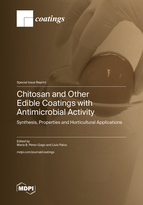Chitosan and Other Edible Coatings with Antimicrobial Activity: Synthesis, Properties and Horticultural Applications
A special issue of Coatings (ISSN 2079-6412). This special issue belongs to the section "Coatings for Food Technology and System".
Deadline for manuscript submissions: closed (7 September 2023) | Viewed by 40238
Special Issue Editors
Interests: edible coatings for horticultural products; gas and mechanical properties of biodegradable films; fresh-cut fruits and vegetables; postharvest physiology; postharvest technology; fruit quality
Special Issues, Collections and Topics in MDPI journals
Interests: postharvest pathology of horticultural produce; alternatives to conventional fungicides; integrated disease management; food additives; biological control; fungal infection; postharvest technology; fruit quality
Special Issues, Collections and Topics in MDPI journals
Special Issue Information
Dear Colleagues,
Antimicrobial edible coatings for entire or fresh-cut fruits and vegetables based on natural biopolymers (i.e., proteins and polysaccharides) that serve as carriers of antimicrobial agents or even are inherently antimicrobial, such as chitosan, are increasingly gaining interest for researchers and industry due to their high potential to provide important produce quality and safety benefits. Additionally, edible coatings can also exert a barrier function to water vapor, gases and other solutes, regulating physiological aspects and eliciting resistance to pathogens in fruit. Altogether, these effects impact positively on the quality, storability, and safety of fruit.
Despite the substantial research progress in antimicrobial edible coatings for fresh and minimally processed fruits and vegetables, the development of tailor-made solutions according to specific commercialization needs still represents a technological challenge because of important physical, physiological, and biochemical differences among the wide variety of fresh horticultural commodities. The development of edible films and coatings with antimicrobial activity requires knowledge about the chemical bases to develop formulations capable of forming edible coatings, the structural characteristics and functionalities that enable their use to coat the horticultural product, the effects of the coatings on different postharvest pathogens in in vitro studies and in different fruit matrices, as well as their effect on the quality during postharvest storage.
This Special Issue aims to cover original research and critical review articles on recent aspects of novel antimicrobial edible coatings formulated with chitosan and other edible coating-forming materials containing salts, natural compounds or antagonistic microorganisms to preserve fresh and minimally processed fruits and vegetables, as well as on the mode of action against postharvest pathogens and their properties to preserve the physicochemical and sensory characteristics of the coated product.
In particular, topics of interest include but are not limited to:
- Biopolymer interactions with active ingredients used in the design of antimicrobial edible coatings for horticultural products;
- Improving biopolymers performance of antimicrobial edible coatings for fruit and vegetable applications;
- Influence of antimicrobial agents on optical, mechanical, and barrier properties of stand-alone edible films;
- Mode of action of antimicrobial edible coatings on different postharvest pathogens;
- Effect of active coating materials to control decay and spoilage due to fungi, bacteria or other contaminating microorganisms of horticultural products during postharvest storage;
- Physiological and metabolic responses of antimicrobial edible coatings in fresh and minimally processed fruits and vegetables during postharvest storage;
- Nutritional and sensory quality of coated horticultural products during postharvest storage.
Dr. María B. Pérez-Gago
Prof. Dr. Lluís Palou
Guest Editors
Manuscript Submission Information
Manuscripts should be submitted online at www.mdpi.com by registering and logging in to this website. Once you are registered, click here to go to the submission form. Manuscripts can be submitted until the deadline. All submissions that pass pre-check are peer-reviewed. Accepted papers will be published continuously in the journal (as soon as accepted) and will be listed together on the special issue website. Research articles, review articles as well as short communications are invited. For planned papers, a title and short abstract (about 100 words) can be sent to the Editorial Office for announcement on this website.
Submitted manuscripts should not have been published previously, nor be under consideration for publication elsewhere (except conference proceedings papers). All manuscripts are thoroughly refereed through a single-blind peer-review process. A guide for authors and other relevant information for submission of manuscripts is available on the Instructions for Authors page. Coatings is an international peer-reviewed open access monthly journal published by MDPI.
Please visit the Instructions for Authors page before submitting a manuscript. The Article Processing Charge (APC) for publication in this open access journal is 2600 CHF (Swiss Francs). Submitted papers should be well formatted and use good English. Authors may use MDPI's English editing service prior to publication or during author revisions.







